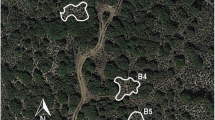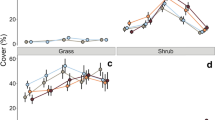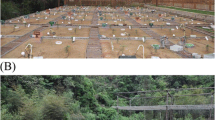Abstract
Nitrogen (N) deposition threatens European Mediterranean ecosystems but investigation and understanding of impacts are limited. We report plant responses from an ongoing field N fertilization experiment conducted in a kermes oak shrubland, where NH4NO3 has been added for 1.5 years at four rates (0, 10, 20, and 50 kg N ha−1 y−1). Two annual plants (Asterolinon linum-stellatum and Limonium echiodes) were negatively affected by N fertilization in terms of density and growth. However, responses were only evident when accounting for between-plot differences in soil NO3 −-N and NH4 +-N. Responses of A. linum-stellatum to simulated N deposition were also dependent on microhabitat, with the most negative effects found in the interspaces between rosemary shrubs. Negative effects were attributed either to increased soil NH4 +-N or to a nutritional (N to P) imbalance. Mycorrhizal infection rates were not altered by N addition in the case of L. echioides, whereas mycorrhizal colonization of A. linum-stellatum roots increased with N in those individuals growing under shrub protection. Living cover of rosemary shrubs was also reduced by simulated N deposition as a consequence of a reduced interannual twig growth. Contrary to annual plants, tissue N content and C:N ratios in rosemary were not affected by simulated N deposition. Overall, our data suggest a high sensitivity of plant communities from moderately polluted semiarid Mediterranean shrublands to N deposition, highlight the role of different forms of inorganic N on plant response to N deposition, and support the importance of conducting similar experiments in other Mediterranean areas spanning a wide range of climatic, soil, and background N deposition conditions.







Similar content being viewed by others
References
Agren GI, Franklin O. 2003. Root:shoot ratios, optimization and nitrogen productivity. Ann Bot 92:795–800.
Allen EB, Rao LE, Steers RJ, Bytnerowicz A, Fenn ME. 2009. Impacts of atmospheric nitrogen deposition on vegetation and soils at Joshua Tree National Park. In: Webb RH, Fenstermaker JS, Heaton JS, Hughson DL, McDonald EV, Miller DM, Eds. The Mojave Desert: ecosystem processes and sustainability. Las Vegas: University of Nevada Press. p 78–100.
Bertness MD, Callaway R. 1994. Positive interactions in communities. TREE 9:191–3.
Bobbink R, Hicks K, Galloway J, Spranger T, Alkemade R, Ashmore M, Bustamante M, Cinderby S, Davidson E, Dentener F, Emmet B, Erisman J-W, Fenn M, Gilliam F, Nordin A, Pardo L, De Vries W. 2010. Global assessment of nitrogen deposition effects on terrestrial plant diversity: a synthesis. Ecol Appl 20:30–59.
Bonanomi G, Caporaso S, Allegrezza M. 2006. Short-term effects of nitrogen enrichment, litter removal and cutting on a Mediterranean grassland. Acta Oecologica 30:419–25.
Brooker RW, Maestre FT, Callaway RM, Lortie CL, Cavieres LA, Kunstler G, Liancourt P, Tielbörger K, Travis JM, Anthelme F, Armas C, Coll L, Corcket E, Delzon S, Forey E, Kikvidze Z, Olofsson J, Pugnaire F, Quiroz CL, Saccone P, Schiffers K, Seifan M, Touzard B, Michalet R. 2008. Facilitation in plant communities: the past, the present, and the future. J Ecol 96:18–34.
Campos-Herrera R, Gómez-Ros JM, Escuer M, Cuadra L, Barrios L, Gutierrez C. 2008. Diversity, occurrence, and life characteristics of natural entomopathogenic nematode populations from La Rioja (Northern Spain) under different agricultural management and their relationships with soil factors. Soil Biol Biochem 40:1474–84.
Crespo A, Barreno E. 1975. Ensayo florístico y ecológico de la vegetación liquénica de los yesos del centro de España (Fulgensietalia desertori). Anal Inst Bot Cavanilles 32:873–908.
Cruz C, Dias T, Matos S, Tavares A, Neto D, Martins-Loução MA. 2003. Nitrogen availability and plant cover: the importance of nitrogen pools. In: Tiezzi E, Brebbia CA, Usó JL, Eds. Ecosystems and sustainable development IV, Vol. 1. Southampton: WIT Press. p 123–35.
Egerton-Warburton L, Allen EB. 2000. Shifts in arbuscular mycorrhizal communities along an anthropogenic nitrogen deposition gradient. Ecol Appl 10:484–96.
Egerton-Warburton LM, Johnson NC, Allen EB. 2007. Mycorrhizal community dynamics following nitrogen fertilization: a cross-site test in five grasslands. Ecol Monogr 77:527–44.
Eschen R, Müller-Schärer H, Schaffner U. 2009. Aboveground environment type, soil nutrient content and arbuscular mycorrhizal fungi explain establishment success of Centaurea jacea on ex-arable land and in late-successional grasslands. Plant Soil 322:115–23.
Fenn ME, Baron JS, Allen EB, Rueth HM, Nydick KR, Geiser L, Bowman WD, Sickman JO, Meixner T, Johnson DW, Neitlich P. 2003. Ecological effects of nitrogen deposition in the Western United States. Bioscience 53:404–20.
Freckleton RP, Watkinson AR, Rees M. 2009. Measuring the importance of competition in plant communities. J Ecol 97:379–84.
Gundale MJ, DeLuca TH, Nordin A. 2011. Bryophytes attenuate anthropogenic nitrogen inputs in boreal forests. Glob Change Biol 17:2743–53.
Hobbs RJ, Richardson DM, Davis GW. 1995. Mediterranean-type ecosystems: opportunities and constraints for studying the function of biodiversity. In: Davis GW, Richardson D, Eds. Mediterranean-type ecosystems. The function of biodiversity. Berlin, Heidelberg: Springer-Verlag. p 1–42.
James JJ, Richards JH. 2005. Plant N capture from pulses: effects of pulse size, growth rate, and other soil resources. Oecologia 145:113–22.
Johnson NC, Rowland DL, Corkidi L, Egerton-Warburton LM, Allen EB. 2003. Nitrogen enrichment alters mycorrhizal allocation at five mesic to semiarid grasslands. Ecology 84:1895–908.
Johnson NC, Rowland DL, Corkidi L, Allen EB. 2008. Plant winners and losers during grassland N-eutrophication differ in biomass allocation and mycorrhizas. Ecology 89:2868–78.
Lortie CJ, Turkington R. 2008. Species-specific positive effects in an annual plant community. Oikos 117:1511–21.
McGonigle TP, Miller MH, Evans DG, Fairchild GL, Swan JA. 1990. A new method which gives an objective measure of colonization of roots by vesicular–arbuscular mycorrhizal fungi. New Phytol 115:495–501.
Maestre FT. 2003. Small-scale spatial patterns of two soil lichens in semi-arid Mediterranean steppe. Lichenologist 35:71–81.
Maestre FT, Cortina J. 2004. Do positive interactions increase with abiotic stress? A test from a semiarid steppe. Proc R Soc B 271:331–3.
Maestre FT, Valladares F, Reynolds JF. 2006. The stress-gradient hypothesis does not fit all relationships between plant–plant interactions and abiotic stress: further insights from arid environments. J Ecol 94:17–22.
Maestre FT, Callaway RG, Valladares F, Lortie CJ. 2009. Refining the stress-gradient hypothesis for competition and facilitation in plant communities. J Ecol 97:199–205.
Martínez-García LB, Armas C, JdD Miranda, Padilla FM, Pugnaire FI. 2011. Shrubs influence arbuscular mycorrhizal fungi communities in a semiarid environment. Soil Biol Biochem 43:682–9.
Nilsson J, Grennfelt P. 1988. Critical loads for sulphur and nitrogen. Skokloster: United Nations Economic Commission for Europe/Nordic Council of Ministers.
Ochoa-Hueso R, Manrique E. 2010. Nitrogen fertilization and water supply affect germination and plant establishment of the soil seed bank present in a semiarid Mediterranean scrubland. Plant Ecol . doi:10.1007/s11258-010-9755-4.
Ochoa-Hueso R, Manrique E. 2011. Effects of nitrogen deposition and soil fertility on cover and physiology of Cladonia foliacea (Huds) Willd., a lichen of biological soil crusts from Mediterranean Spain. Environ Pollut 159:449–57.
Ochoa-Hueso R, Allen EB, Branquinho C, Cruz C, Dias T, Fenn ME, Manrique E, Pérez-Corona ME, Sheppard LJ, Stock WD. 2011. Nitrogen deposition effects on Mediterranean-type ecosystems: an ecological assessment. Environ Pollut . doi:10.1016/j.envpol.2010.12.019.
Ochoa-Hueso R, Stevens CJ, Ortiz-Llorente MJ, Manrique E. 2013. Soil chemistry and fertility alterations in response to N application in a semiarid Mediterranean shrubland. Sci Total Environ. doi:10.1016/j.scitotenv.2013.02.049.
Padgett PE, Allen EB. 1999. Differential responses to nitrogen fertilization in native shrubs and exotic annuals common to Mediterranean coastal sage scrub of California. Plant Ecol 144:93–101.
Pérez-Fernández MA, Rodríguez-Echeverría S. 2003. Effect of smoke, charred wood, and nitrogenous compounds on seed germination of ten species from woodland in Central-Western Spain. J Chem Ecol 29:237–51.
Perry JN, Winder L, Holland JM, Alston RD. 1999. Red-blue dots for detecting clusters in count data. Ecol Lett 2:106–13.
Phoenix GK, Hicks WK, Cinderby S, Kuylenstierna JCI, Stock WD, Dentener FJ, Giller KE, Austin AT, Lefroy RDB, Gimeno BS, Ashmore MS, Ineson P. 2006. Atmospheric nitrogen deposition in world biodiversity hotspots: the need for a greater global perspective in assessing N deposition impacts. Glob Change Biol 12:470–6.
Pugnaire FI, Armas C, Valladares F. 2004. Soil as a mediator in plant–plant interactions in a semiarid community. J Veg Sci 15:85–92.
Rashid I, Reshi Z, Allaie RR, Wafai BA. 2007. Germination ecology of invasive alien Anthemis cotula helps it synchronise its successful recruitment with favourable habitat conditions. Ann Appl Biol 150:361–9.
Rivas-Martínez S. 1987. Memoria del mapa de series de vegetación de España. Madrid: ICONA.
Sala OE, Chapin FSIII, Armesto JJ, Berlow E, Bloomfield J, Dirzo R, Huber-Sanwald E, Huenneke LF, Jackson RB, Kinzig A, Leemans R, Lodge DM, Mooney HA, Oesterheld M, Poff NL, Sykes MT, Walker BH, Wall DH. 2000. Global biodiversity scenarios for the year 2100. Science 287:1770–4.
Santos JC, Finlay RD, Tehler A. 2006. Molecular analysis of arbuscular myccorhizal fungi colonizing a semi-natural grassland along a fertilization gradient. New Phytol 172:159–168.
Sardans J, Rodà F, Peñuelas J. 2005. Effects of water and nutrient pulse supply on Rossmarinus officinalis growth, nutrient content and flowering in the field. Environ Exp Bot 53:1–11.
Smemo KA, Zak DR, Pregitzer KS. 2006. Chronic experimental NO3 − deposition reduces the retention of leaf litter DOC in a northern hardwood forest soil. Soil Biol Biochem 38:1340–7.
Van der Waal C, de Kroon H, de Boer WF, Heitkönig IMA, Skidmore AK, de Knegt HJ, van Langeveldem F, van Wieren SE, Grant RC, Page BR, Slotow R, Kohi EM, Mwakiwa E, Prins HHT. 2009. Water and nutrients alter herbaceous competitive effects on tree seedlings in a semiarid savannah. J Ecol 97:430–9.
Vitousek PM, Porder S, Houlton BZ, Chadwick OA. 2010. Terrestrial phosphorus limitation: mechanisms, implications, and nitrogen–phosphorus interactions. Ecol Appl 20:5–15.
Vivanco MG, Palomino I, Vautard R, Bessagnet B, Martín F, Menut L, Jiménez S. 2009. Multi-year assessment of photochemical air quality simulation Spain. Environ Modell Softw 24:63–73.
Vourlitis GL, Pasquini SC. 2009. Experimental dry-season N deposition alters species composition in southern Californian Mediterranean-type shrublands. Ecology 90:2183–9.
Vourlitis GL, Pasquini SC, Mustard R. 2009. Effects of dry-season N input on the productivity and N storage of Mediterranean-type shrublands. Ecosystems 12:473–88.
Wilson GWT, Rice CW, Rillig MC, Springer A, Hartnett DC. 2009. Soil aggregation and carbon sequestration are tightly correlated with the abundance of arbuscular mycorrhizal fungi: results from long-term field experiments. Ecol Lett 12:452–61.
Witkowski EFT. 1989a. Response to nutrient additions by the plant growth forms of sand-plain lowland fynbos, South Africa. Vegetatio 79:89–97.
Witkowski EFT. 1989b. Effects of nutrient additions on litter production and nutrient return in a nutrient-poor Cape fynbos ecosystem. Plant Soil 117:227–35.
Xia J, Wan S. 2008. Global response patterns of terrestrial plant species to nitrogen addition. New Phytol 179:428–39.
van der Heijden MGA, Boller T, Wiemken A, Sanders IR. 1998. Different arbuscular mycorrhizal fungi species are potential determinants of plant community structure. Ecology 79:2082–91.
Yoshida LC, Allen EB. 2001. Response to ammonium and nitrate by a mycorrhizal invasive grass and native shrub in Southern California. Am J Bot 88:1430–6.
Acknowledgments
This research was finally supported by the Spanish Ministerio de Educación y Ciencia (CGL-2009-11015) and the Comunidad de Madrid (REMEDINAL-2 (S-0505/AMB/0335; S-0505/AMB/00321). ROH was also funded by an FPU fellowship (AP2006-04638). We are very thankful to Daniel de la Puente for helping with the field experiment set up. Octavio Cedenilla and María Luisa Andrés were an invaluable help with the soil physico-chemical analyses. We want to specially thank Dr. José Javier Pueyo for his personal involvement within this project and Mike D. Bell for his revision of the English. Our editors (Dr. Monica G. Turner and Dr. Gary M. Lovett) and three anonymous reviewers are also greatly acknowledged.
Author information
Authors and Affiliations
Corresponding author
Additional information
Author Contributions
ROH: experimental design, field work, laboratory analyses, data analyses, manuscript writing. EPC: laboratory analyses, manuscript writing. EM: experimental design, field work, manuscript writing.
Electronic supplementary material
Below is the link to the electronic supplementary material.
Figure S1
Study site in the Nature Reserve “El Regajal-Mar de Ontígola”. (a) Quercus coccifera ticket with interspaces dominated by Rosmarinus officinalis and other Mediterranean shrubs. (b) Experimental block and plot. (c) Experimental plot subdivided into quadrats and subquadrats where the counts were made (TIFF 5470 kb)
Rights and permissions
About this article
Cite this article
Ochoa-Hueso, R., Pérez-Corona, M.E. & Manrique, E. Impacts of Simulated N Deposition on Plants and Mycorrhizae from Spanish Semiarid Mediterranean Shrublands. Ecosystems 16, 838–851 (2013). https://doi.org/10.1007/s10021-013-9655-2
Received:
Accepted:
Published:
Issue Date:
DOI: https://doi.org/10.1007/s10021-013-9655-2




